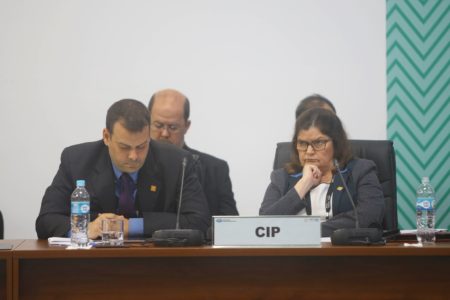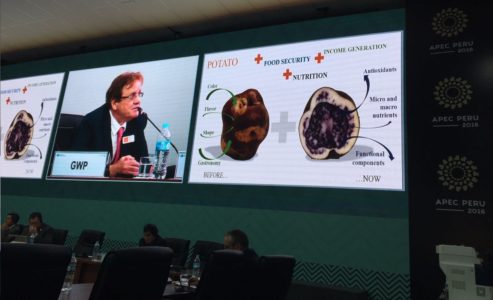For the past two-plus weeks, numerous CIP officials were present at the Asia-Pacific Economic Cooperation (APEC) meeting in Piura, Peru, discussing food security and climate change.
Members of the 21 APEC “economies” – APEC’s term for its member countries – were present at talks given by CIP’s director general Barbara Wells and others at the event.
In her remarks, Wells reminded APEC attendees to pay close attention to the effects of climate change on global crops.

“Climate change and increasingly extreme weather patterns and events are all having huge impacts on agricultural production,” she noted. “The economic effects on local communities are staggering. Crop yields are under threat, as are traditional crops grown in areas where climate change may force radical changes in cropping patterns. Climate resilience and tolerance to drought, heat and salinity are fundamental characteristics to coping with a changing climate.”
“Our scientists around the globe work with smallholder farmers and their communities who have already been feeling the impact of climate change,” she added.
According to the UN’s Food and Agriculture Organization, FAO, small farmers account for up to 80 percent of the food supply in the Asian and Sub-Saharan African economies.
 For his part, Andre Devaux, Latin American and Caribbean Regional Leader at CIP, gave a presentation during the plenary session of APEC’s Policy Partnership on Food Security (PPFS), chaired by Peru’s Vice Minister of Agritculture, Juan Carlos Gonzales.
For his part, Andre Devaux, Latin American and Caribbean Regional Leader at CIP, gave a presentation during the plenary session of APEC’s Policy Partnership on Food Security (PPFS), chaired by Peru’s Vice Minister of Agritculture, Juan Carlos Gonzales.
Devaux, whose talk was entitled “Food Systems Integrating Production, Value Chan and Nutritional Approaches,” said he received questions from listeners about how to help smallholder farmers cope with climate change; what types of approaches CIP is developing and/or implementing to enhance sustainable agriculture; and how CIP is developing ways to promote native potato products, such as purple, brown and orange chips made from Andean roots and tubers.
Devaux noted that such products “are becoming an important niche market with potential for export.”
He spotlighted other CIP projects that have yielded good results, including work to link enhanced sweetpotato production with better nutrition – and consequently, better health – for children in SubSaharan Africa and other regions of the world.
Listeners “indicated that they had learned a lot about CIP and on the contribution of potato to global food security,” Devaux said.
As the forum draws to a close, Pietro Turilli, CIP’s director of resource mobilization, spoke to the many synergies between CIP and the economic forum, which will next convene in Vietnam in 2017.
“APEC brings together 21 countries that have the ability to address many of the regional and global food, agriculture and climate change challenges we face,” Turilli said. In speaking to the member-states collectively, CIP had met its goals of using both its mandate and it local presence to raise awareness of global challenges “and help motivate member states to invest in technical and political solutions that [could] involve CIP.”
